Northeast Ohio is the final resting place of many historical figures as well as a place where certain events shaped the lives of thousands. Here is a list of graves and historical markers to visit, pay your respects to or just indulge your morbid curiosity.
To make things easier to find, you'll find an interactive map below with the locations of every grave and marker.
Garrett A. Morgan
March 4, 1877 - July 27, 1963

Morgan was a Black inventor credited with creating the early version of the traffic light and gas mask. He was born to Sydney Morgan, a former slave and son of the Confederate colonel John H. Morgan. His mother, Eliza Reed, was also a former slave.
At the age of 14, Morgan moved to Cincinnati and was educated under a private tutor. He settled in Cleveland in June 1895 and later set up a sewing machine business in 1907 and a tailoring shop in 1909.
In 1905, he discovered how to make a hair-straightening solution and in 1913 he created G.A. Morgan Hair Refining Co. to market the product.
Morgan was a tinkerer, constantly working on inventing something new.
In 1923, Morgan sold his traffic signal to the General Electric Company for $40,000. Unlike other signals of that era that used “stop” and “go,” Morgan’s signal had a third caution signal in between the two. Morgan’s signal was the precursor to the traffic signal lights in use today.
He's buried in Lake View Cemetery, Cleveland.
Charles Francis Brush Sr.
March 17, 1849 - June 15, 1929

Brush was an inventor who brought electric lighting to Public Square in Cleveland in 1879—the first city in the world to feature electric “Brush” arc lights. Within three years, Brush lights were used worldwide.
Brush created the Brush Electric Company which was later bought by Thomas Houston Electric Company and merged with Edison Electric Company to form General Electric in 1891.

The year before his death, Brush created the Brush Foundation to honor his son who died in 1927. An interesting note is the Brush Foundation “played a significant role in the organization and funding of the Intl. Planned Parenthood Federation” created in 1949.
Brush is buried in Lake View Cemetery, Cleveland.
John D. Rockefeller Sr.
July 8, 1839 - May 23, 1937

Rockefeller Sr. was the founder of Standard Oil Co. By 1872, Standard Oil owned nearly two dozen Cleveland oil refineries. It would later become BP America.
He was worth $1.4 billion when he died in 1937. His net worth was the equivalent to 1.5% of the entire country’s GDP.

He's buried in Lake View Cemetery, Cleveland.
James Abram Garfield
Nov. 19, 1831 - Sept. 19, 1881
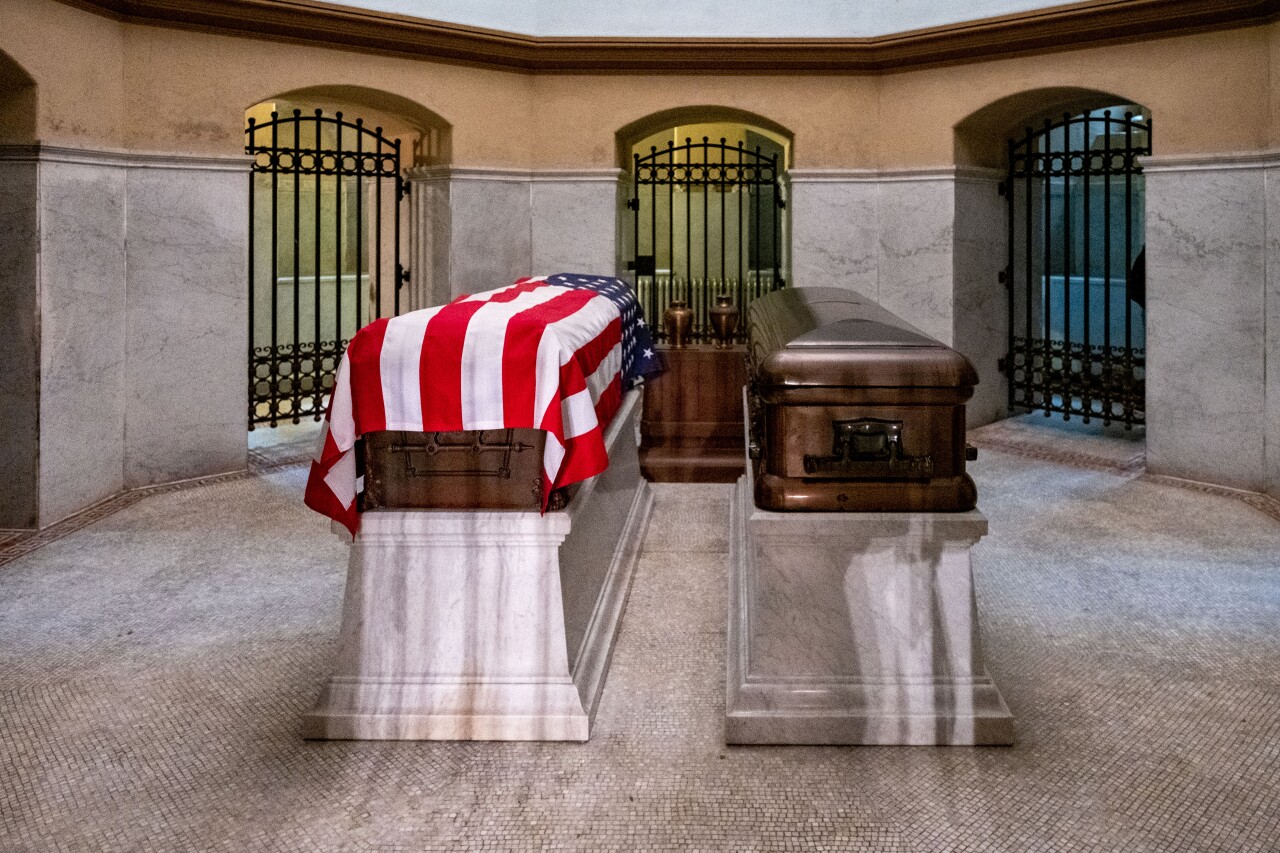
Garfield was the 20th US president. He only served in the position a few months before he was shot at a railroad station in Washington D.C. by an assassin on July 2, 1881. He would die several months later. He spent a total of 200 days as president.

During the Civil War, Garfield served as a major general. Following that, he spent 17 years in the U.S. House of Representatives.
The city of Garfield Heights is named after Garfield Park, which was named after him. The Garfield Monument was built in May 1890 and holds his remains and those of his wife, Lucretia Rudolph Garfield. The Garfield Monument is located in Lake View Cemetery, Cleveland.

Other presidents buried a few hours drive from Cleveland include: William McKinley in Canton and Rutherford B. Hayes in Fremont.
Eliot Ness
April 19, 1903 - May 16, 1957

Ness was famous for leading the Chicago “Untouchables” who brought down Al Capone. He came to Cleveland in 1934 as the head of the Alcohol Tax Unit for the Northern District of Ohio.
In 1935, he was appointed Cleveland Safety Director and was tasked with cleaning up a “scandal-ridden police department.” He created the police department’s traffic division, modernized the fire department and created the Cleveland Police Academy.
He also investigated the “Torso Murders” that occurred between Sept. 1935 and 1938 in Cleveland near the Kingsbury Run area. Twelve people were murdered and their bodies mutilated and dumped. The killings stopped when Ness ordered a homeless shantytown in Kingsbury Run burned to the ground.
Ness had an unsuccessful bid for Cleveland mayor in 1947.
His ashes were scattered in a pond in Lake View Cemetery and a cenotaph was erected nearby.
Alan Freed
Dec. 15, 1922 - Jan. 20, 1965
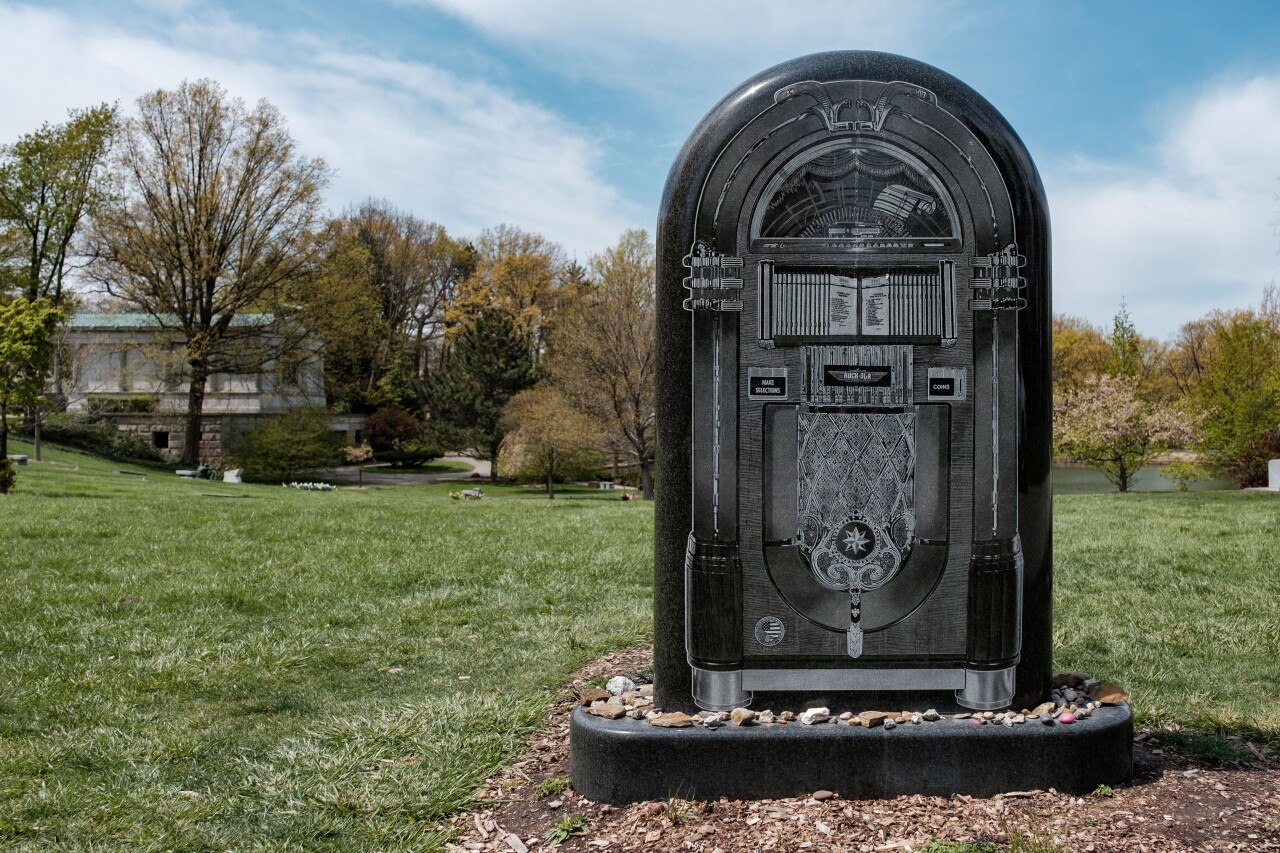
Freed was a radio broadcaster credited with coining the phrase “rock n’ roll.”
He hosted a late night radio show called “The Moondog Rock & Roll House Party.” Freed promoted the first rock n’ roll concert, called the Moondog Coronation Ball, in 1952; it took place at the Cleveland Arena.
His broadcast career ended in 1959 when he chose not to sign an FCC document that said he never received gifts or money for playing certain records on the air. He moved to Miami and died of kidney failure six years later.

He was cremated and his ashes in a mausoleum in New York. In 2002, his ashes were sent to Cleveland, placed in a wall at the Rock Hall and then an exhibition display case. When the exhibition ended in 2014, his ashes were moved to Lake View Cemetery and kept in a locked vault until the current headstone and burial plot was created.
Freed is buried in Lakeview Cemetery, Cleveland.
Dr. Sam Sheppard
Dec. 29, 1923 - April 6, 1970

Sheppard was a doctor convicted of murdering his wife Marilyn Reese Sheppard in 1954 in their Bay Village home and sentenced to life in prison.
The first trial was heavily publicized and had nationwide media coverage. The U.S. Supreme Court determined in 1966 that the judge in Sheppard’s first trial failed to protect Sheppard from the “inherently prejudicial publicity that saturated the country.”
According to Case Western Reserve University, the U.S. Supreme Court determined Sheppard “was not sufficiently insulated from the excessive publicity surrounding the case, and thus was denied a fair trial in Cuyahoga County Common Pleas Court. This decision helped define what protections from adverse media coverage were necessary under the 14th Amendment to the Constitution.”
The State of Ohio later retried Sheppard but lost, and he was exonerated after spending 10 years in prison. He died four years later of liver failure.
He's buried in a mausoleum with his wife at Knollwood Cemetery, Mayfield Heights.
Collinwood School Fire Memorial
March 4, 1908
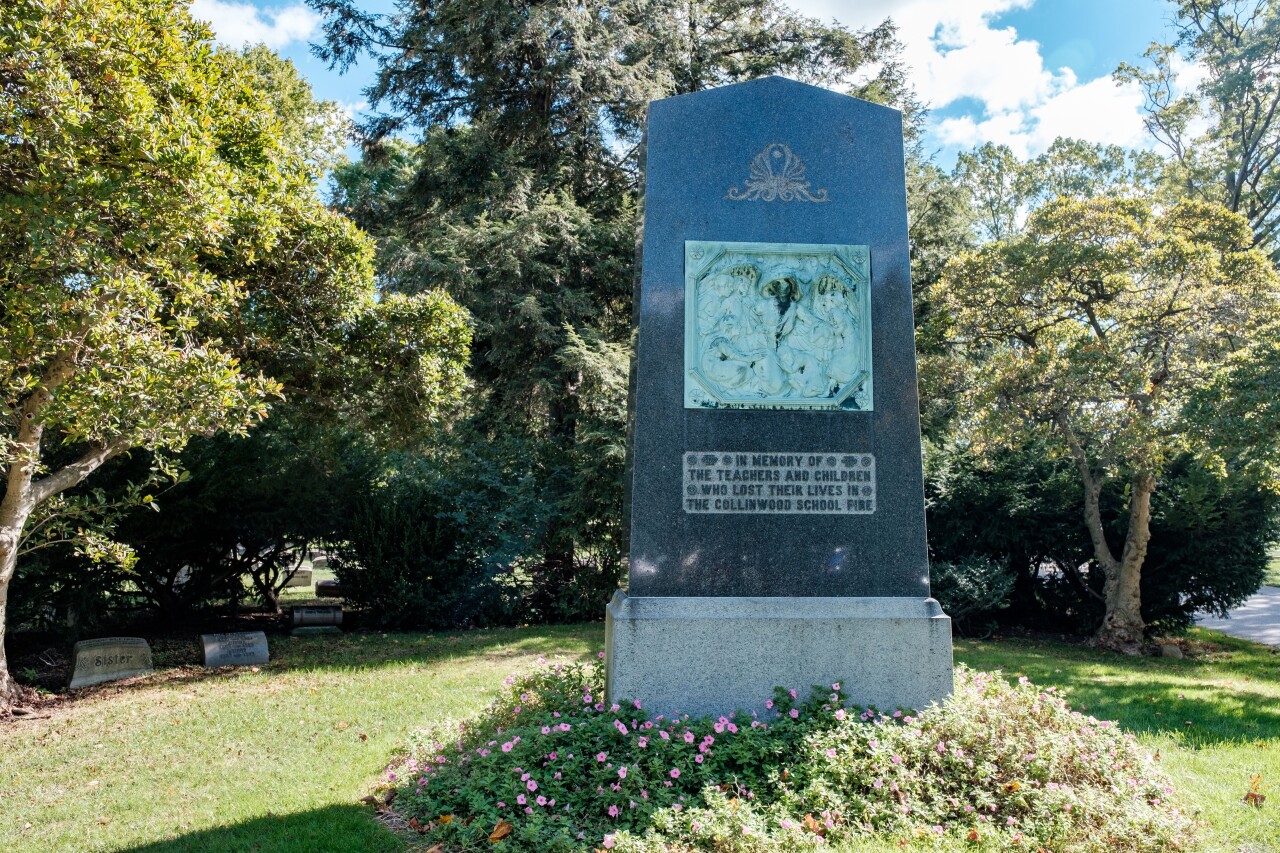
On March 4, 1908, an overheated steam pipe at Lakeview Elementary School in Collinwood touched a wooden joist and set fire to the school. In total, 172 children and two teachers died as a result of the fire.
It was initially thought that the victims were unable to escape the school because they couldn’t get the inward-opening door open due to panicked children pushing against the door.
However, a further investigation showed that the door to the school actually opened outward. A report concluded that “the children's failure to escape resulted from their own panic. The fleeing children became wedged tightly on the stairs behind a set of inner vestibule doors which were narrower than the outer doors.”
The incident prompted school inspections across the country and stricter laws regarding building safety.
The children were buried in a common grave in Lake View Cemetery and a memorial marker was erected nearby.
The memorial is in Lake View Cemetery, Cleveland.
Chief Thunderwater
Sept. 10, 1865 - June 10, 1950

Oghema “Chief Thunderwater” Niagara was a Native American who was part of the Buffalo Bill Cody’s Wild West show and later became a political activist and businessman.
He came to Cleveland in the early 1900s and started a company selling polish and herbal tea. Over the next 50 years until his death, he helped Native Americans who lived in the area or traveled to Cleveland by offering them shelter.
Niagara advocated for the protection of the Erie Street Cemetery in Cleveland, located near Progressive Field, due to the grave of another Native American buried there — Joc-O-Sot, a Sauk warrior who fought in the Black Hawk War of 1832, died in Cleveland and was buried at the cemetery in 1844.

Niagara educated white residents about Native Americans through his participation in the Early Settlers Association of the Western Reserve.
He's buried in Erie Street Cemetery, Cleveland, next to Joc-O-Sot.
Henry Alden Sherwin
Sept. 27, 1842 - June 26, 1916

In 1866, Sherwin founded the Sherwin-Williams Company that would later become part of the economic backbone of Cleveland that survives to this day, more than 155 years later.
His company revolutionized the paint industry in 1875 when it released pre-mixed paint. Prior to that, paint was sold as ingredients that customers had to mix themselves.
Sherwin expanded his empire through the late 1800s by buying other companies and expanding “vertically,” meaning his company reduced its dependence on supplies from other companies, including lead, zinc and copper mines in New Mexico and the manufacture of additional plants to produce ingredients needed in paint at the time.
By 1900, the company had more than $2 million in sales.
In 1905, Sherwin’s company created the “Cover the Earth” slogan and logo showing a can pouring paint over the world.
Williams retired from the company in 1909.
He’s buried in Lake View Cemetery, Cleveland.
David Mark Berger
May 24, 1944 - Sept. 6, 1972

A native of Shaker Heights, Berger was an Olympic weightlifter who also held a doctorate in law from Columbia University.
He moved to Israel in the early 1970s and competed in the 1971 Asian Games where he won a silver medal. In 1972, he made the Israeli Olympic team and competed in the Summer Olympic Games in Munich, Germany.
On Sept. 5, 1972, a group of Palestinian terrorists who were part of “Black September” went to the apartments where Berger and 10 other Israeli Olympians were staying. The terrorists killed two athletes and took nine others hostage. The group demanded the release of hundreds of Arab prisoners who were incarcerated in Israeli prisons.
The terrorists moved the hostages to Fürstenfeldbruck Air Base where police were waiting to ambush them. In the ensuing gunfight, the rest of the hostages, including Berger, were killed along with one German police officer and five of the terrorists.
Berger is buried in Mayfield Cemetery, Cleveland Heights. In Beachwood, the David Berger National Memorial stands as a remembrance to those who died in the attack.
Dr. James Henry Salisbury
Oct. 13, 1823 - Aug. 23, 1905

Salisbury was a doctor and researcher who studied germ theory in the mid-19th Century. During the Civil War, he worked as a physician.
Salisbury believed malnutrition to be one of the deadliest threats to soldiers during the war. He thought food was the key to health and could cure ailments.
At a time when hard tack—dry, often stale crackers and biscuits—were the mainstays of the soldier's diet, Salisbury created a dish made of minced meat that had the nutrients he believed were needed to stay healthy and tested his theory on soldiers.
Those experimental, all protein—low-carb meals later became known as Salisbury Steak, and following the war would become one of the country’s first fad diets. Salisbury published a book on his findings and studies.
“For about two decades the diet—not that different, when you think of it, from extreme versions of the low-carb diets of recent years—was all the rage," wrote Lisa Bramen with Smithsonian Magazine.
Salisbury is buried in Lake View Cemetery, Cleveland.
Stefania Walasiewicz “Stella Walsh”
April 3, 1911 - Dec. 5, 1980

Walsh grew up in Poland and moved to Cleveland in 1911. She set a world record in 1930 for the 100-yard dash, and two years later competed in the Olympics in Los Angeles where she won a gold medal. She won a silver medal in the 1936 Olympics.
Walsh was killed outside a store in Cleveland when she was struck by gunfire during a robbery.
Following her death, the legitimacy of her records and Olympic medals was called into question when the public found out about the personal details of her life and debated if she was a man.
Cuyahoga County Coroner Samuel Gerber wrote in Walsh’s autopsy report that she had a genetic condition that caused her to have mostly male chromosomes and ambiguous genitalia.
The International Olympic Committee ultimately chose not to rescind her medals because “gender determination tests were not conducted during the years she participated as an Olympian."
The county coroner who conducted her autopsy stated, "Socially, culturally, and legally, Stella Walsh was accepted as a female for 69 years. She lived and died as a female."
Walsh is buried in Calvary Cemetery, Cleveland.
Alexander Winton
June 20, 1860 - June 21, 1932

Ten years before Henry Ford released the Model T, Alexander Winton was already producing automobiles in Cleveland.
In 1896, Winton created his first automobile in Cleveland. A year later, Winton formed the Winton Motor Carriage Company.
In 1898, Winton introduced his American-made standard-model gasoline automobile. Each of Winton’s vehicles were built by hand and featured luxurious trimmings, such as painted sides, leather roofs, padded seats and gas lamps. The tires were manufactured by the B.F. Goodrich company. At a whopping 10 horsepower, the cars could hit 33 mph.
Winton Carriage Company became the largest manufacturer of automobiles in the country that same year.
Two things happened that would signal the decline in Winton’s place as king of cars.
In 1898, Winton sold a car to James Ward Packard. Packard reportedly wasn’t satisfied with his purchase and complained to Winton. His concerns fell on deaf ears and Winton challenged him to “do better” if he wasn’t happy with the product. Packard would go on to create the Packard Motor Car Company.
Winton’s other blunder happened when his chief engineer urged him to hire a young engineer named Henry Ford. Winton reportedly “wasn’t impressed” by Ford and passed on hiring him.
Ford later revolutionized the automobile industry by producing cars at a faster rate and at a much lower price to consumers.
Winton sold his company to General Motors in 1930 after he was unable to compete with Ford’s cheaper cars and the other manufacturers who stepped into the industry.
He’s buried in Lake View Cemetery, Cleveland.
Marion Motley
June 15, 1920 - June 27, 1999

Jackie Robinson is often brought up as the person who broke the racial barrier in professional sports. But in 1946, one year before Robinson signed with the Brooklyn Dodgers, the Cleveland Browns signed Marion Motley.
Motley was born in Canton and served in the U.S. Navy during World War II. During his service, he played under Paul Brown who later asked Motley to try out for the Cleveland Browns, which Paul Brown served as the head coach for.
Motley was an imposing athlete. At 6 feet, 1 inch tall and 232 pounds, he played nine seasons with the team. He amassed 4,720 yards on 828 carries for a 5.7 yard-per-carry average. During a game against the Pittsburgh Steelers in 1950, Motley rushed 188 yards on 11 carries for a 17.1 yard-per-carry average.
Motley was elected to the Pro Football Hall of Fame in 1968 and named in to the NFL’s 75th Anniversary All-Time Team in 1994.
He's buried in Evergreen Memorial Park Cemetery, Bedford Heights.
Vernon Bigelow Stouffer
Aug. 22, 1901 - July 26, 1974

While the name Stouffer may make you think of the frozen food aisle in your favorite grocery store, in the 1920s, the name meant something entirely different to Cleveland.
Vernon Stouffer’s father Abraham first introduced Cleveland to the family name when he opened a dairy counter inside The Arcade on Euclid Avenue in 1922 where the family sold milk, cheese sandwiches and apple pies.
Two years later, the father and son opened a restaurant named Stouffer’s Lunch, which later became a chain. They opened restaurants across Cleveland as well as in Pittsburgh, Detroit, Philadelphia and New York.
The elder Stouffer died in 1936, but Vernon kept the family business going. In 1946, he set his sights on partially prepared food you could make at home, and the Stouffer frozen food business was born.
Stouffer diversified his interests and purchased hotels in addition to expanding his frozen food empire. He turned to sports in 1966 when he bought a controlling interest in the Cleveland Indians. He sold the team in 1972.
He’s buried at Lakewood Park Cemetery, Rocky River.
Cleveland East Ohio Gas Explosion
Oct. 20, 1944
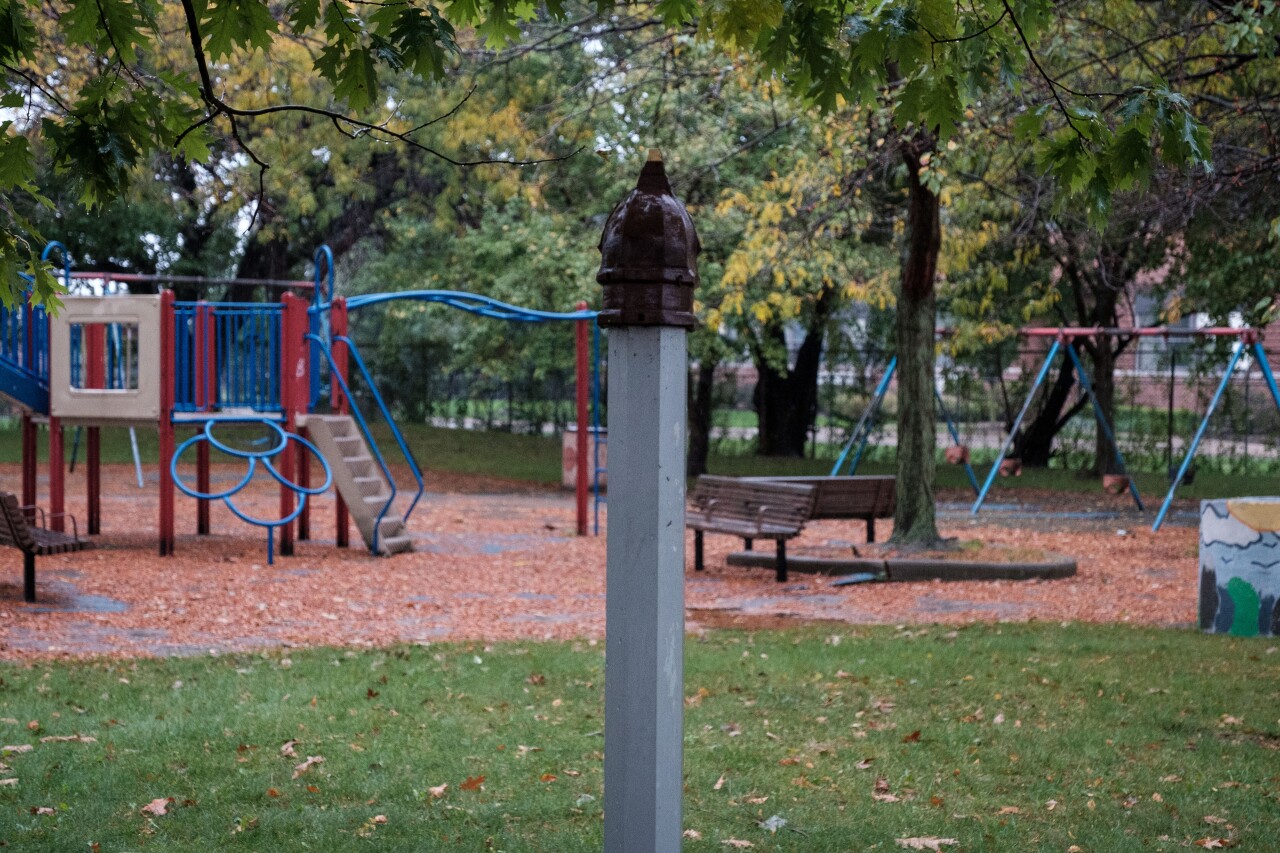
On a Saturday afternoon in October 1944, one of the worst disasters in Cleveland history happened. At around 2:30 p.m., vapor started to leak from a tank near the north end of East 61st Street that held liquid natural gas.
When the gas mixed with oxygen, it became combustible and exploded, creating a “tidal wave of fire” that destroyed everything in a square mile on the city's East Side. The fires from the explosion spread across 20 blocks, destroying some homes but passing over others.
Around 130 people died in the explosion and subsequent fires. Seventy-nine homes were destroyed as well as 217 cars, two factories, seven trailers and one tractor. Nearly 700 people were left homeless.
The event sparked a call for additional safety measures and regulations regarding the storage of natural gas. Cleveland East Ohio Gas Company later became Dominion East Ohio.
A historical marker is located at Grdina Park, Cleveland. However, the plaque has since been broken off and removed.
Bob Feller
Nov. 3, 1918 - Dec. 15, 2010

Imagine being a high school student and playing for a professional baseball team. That was the reality for Robert William Andrew “Bob” Feller.
Feller was found by Indians scout Cy Slapnicka in Van Meter, Iowa, and signed to a contract for $1 and an autographed baseball.
He played in an exhibition game at League Park against the Cardinals and struck out eight of the nine batters he went up against. His Major League debut was on July 19, 1936. He was 17 years old at the time. In his first start the following month, he struck out 15 batters, just one shy of a league record. Two years later, he would set a league record that held for 30 years—he struck out 18 batters in one game.
When America joined World War II after the bombing of Pearl Harbor, Feller joined the Navy. After the war ended, Feller returned to the Indians and retired following the 1956 season. He was inducted into the Baseball Hall of Fame in 1962. A statue of Feller stands outside Progressive Field.
Feller is buried in Gates Mills North Cemetery, Gates Mills.
Recently, Feller's home in Gates Mills was listed for sale. It can be yours for a cool $700,000.

One of the most unique graves in Ohio is a life-size bronze sculpture of an angel that appears to be crying and holding an upside down torch. The sculpture was created by Cleveland Sculptor Herman Matzen and towers over the headstones of the Haserot family.
The statue’s real name is The Angel of Death Victorious, and if you look close, you will see that it is holding a torch upside down, “a symbol of life extinguished.”

Its most startling feature is what gave the sculpture its nickname—The Weeping Angel. Black streaks, likely created by rain that discolored the bronze, form below the angel’s eyes and travel down its face. The effect creates an eerie appearance and makes it seem like the angel is crying.

Francis Haserot, the family’s patriarch, was born in Cleveland on Dec. 19, 1860. He was a businessman in the city for decades and a partner in the grocery firm of W.J. Hayes & Company in Cleveland. He later created the Haserot Company—a mercantile house based in Cleveland that had business worldwide, importing coffee, tea and other goods.
The Girl in Blue
Dec. 24, 1933

On Christmas Eve in 1933, a 22-year-old woman wearing a blue dress and blue shoes was struck by a New York Central passenger train in Willoughby.
Somehow, despite being struck by a train, she sustained no visible injuries. Her body was laid out at a local funeral home and more than 3,000 people came to pay their respects to the unknown woman.

Not sure of who she was, the townsfolk took up a collection and buried her with a simple headstone that said — "In memory of the Girl in Blue / Killed by Train / December 24, 1933 / Unknown but not forgotten."
For 60 years, her identity remained a mystery. But in 1993, her name was finally discovered. The Girl in Blue was Josephine “Sophie” Klimczak. A secondary marker was later placed at the foot of the original headstone.
Klimczak is buried at Village Cemetery, Willoughby.
Hector Boiardi
1897- 1985

Did you know that Chef Boyardee was a real person who lived in Cleveland? Born in Italy in 1897, Ettore “Hector” Boiardi moved to New York in 1914 and worked at the Ritz Carlton hotel. In 1917, he moved to Cleveland to work as the head chef at Hotel Winton and served spaghetti dinners that become the “talk of the Midwest.”
In 1924, he opened his first restaurant, Giardino d’Italia, with his wife Helen Wroblewski. Four years later, the chef was selling his products in stores across the area under the phonetic name Boy-ar-dee.

In World War II, Boiardi moved his production plant to Pennsylvania and made field rations for the military.
He later sold the company to American Home Foods but stayed on as a consultant until 1978.
He’s buried next to his wife at a mausoleum in All Souls Cemetery, Chardon.
Levi Scofield
Nov. 9, 1842 - Feb. 25, 1917

If there is one person in Cleveland whose legacy is visible today, that would be Levi Scofield.
Scofield was the architect behind the Soldiers and Sailors Monument in Public Square and the Schofield building that was recently restored to its previous glory. He’s also the person who designed the Ohio State Reformatory in Mansfield and the Athens Asylum.
Scofield also served as a first lieutenant and captain in the Civil War.
Born Levi Tucker Schofield, he would later drop the “H” in his name. However, his mausoleum still bears the letter.
He’s buried in Lake View Cemetery, Cleveland.
Raymond Johnson “Ray” Chapman
Jan. 15, 1891 - Aug. 17, 1920

Chapman was a shortstop for the Cleveland Indians who joined the team in 1912 and died from an injury sustained in a game.
On Aug. 16, 1920, Chapman was struck in the head by a baseball thrown by the New York Yankees’ Carl Mays at the New York Polo Grounds. Chapman was taken to a hospital and later died.

His body was returned to Cleveland and his funeral was one of the largest the city ever held.
Known as a player who put the team above personal gain, Chapman set an MLB record with 67 sacrifices in 1917. He also set a team record of 55 stolen bases that wasn’t broken until 1980.

He’s buried in Lake View Cemetery, Cleveland.
Sara Lucy Bagby Johnson
1843 - July 14, 1906

Johnson was the last Black person in the country prosecuted under the U.S. Fugitive Slave Act.
In 1852, Johnson was bought by John Goshorn for $600 in Virginia. Eight years later, she escaped to Pennsylvania through the Underground Railroad. After arriving in the free states, she moved to Cleveland and worked as a servant for congressman-elect A.G. Riddle. She was later employed by Lucious A. Benton, who was a jeweler.
But on Jan. 16, 1861, Goshorn arrived in Cleveland seeking his lost “property.” She was arrested by the U.S. Marshals Service under the slave act of 1850. She was later freed during the Civil War by a union soldier and moved to Pittsburgh before returning to Cleveland.
She’s buried in Woodland Cemetery in Cleveland. Her headstone states “Unfettered and Free.”
Robert Lockwood Jr.
March 27, 1915 - Nov. 2, 2006

Lockwood was a bluesman who played professionally by the age of 15. He was mentored by the legendary Robert Johnson, and would in turn, go on to mentor others such as B.B. King, who he gave guitar lessons to.
He grew up on a farm in Turkey Scratch, Arkansas and “honed his musical craft in juke joints and street corners in the Mississippi Delta region.” By the 1950s, Lockwood had moved north to Chicago and settled in Cleveland in the 60s where he was a fixture at venues like the Pirates Cove and Brothers Lounge when he wasn’t touring the country.
During his 70-year career, Lockwood would produce 16 studio albums. His accolades include two National Blues Music Awards and four W.C. Handy Awards. He was inducted into Blues Hall of Fame in 1989 and won a posthumous Grammy in 2008. His guitar is on display at the Rock & Roll Hall of Fame.
He’s buried in Riverside Cemetery, Cleveland.
Jeptha Homer Wade Sr.
Aug. 11, 1811 - Aug. 9, 1890

Before telephones, the telegraph ruled and Wade was responsible for putting people in touch with each other across vast distances.
Born in Romulus, New York, Wade originally worked as a portrait painter and operated a factory. In 1847, he worked as a subcontractor for J.J. Speed and made telegraph lines in Michigan. Several years later, he would make lines in Cleveland, Cincinnati and St. Louis.
In 1854, he merged his lines with those of the Royal E. House and two years later became a founding member of Western Union Telegraph Co. when 13 companies' lines were consolidated. In 1856, he moved to Cleveland and became the director of eight railroad companies. He briefly served as president of Western Union in 1866 but resigned the following year due to poor health.
That same year, he helped create the Citizens Savings and Loan Association and became president of the company in 1868. In the 1880s he donated dozens of acres of land to Cleveland that would later become Wade Park and the future home of the Cleveland Museum of Art and the Cleveland Botanical Garden.
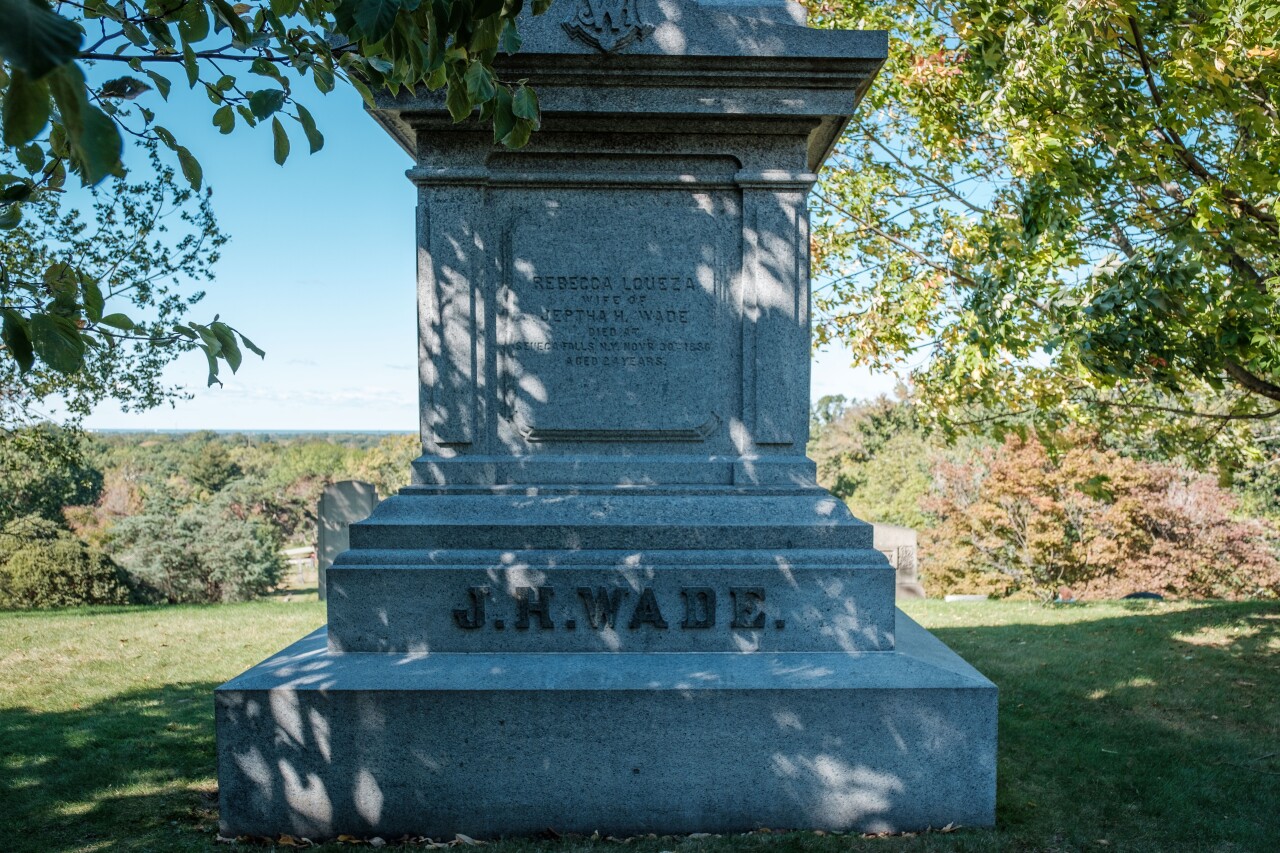
He also served as the first president of the Lake View Cemetery Association.
Following his death, Wade’s grandson had Wade Memorial Chapel in Lake View Cemetery created in his honor. The building, which looks like a Greek temple, features marble columns and two-ton bronze doors. The building’s interior was designed by Louis Comfort Tiffany’s firm (yes, that Tiffany). Its most stunning feature is a stained glass window called “The Flight of Souls” that depicts the consummation of the Divine Promise and was designed by Tiffany himself. Before being placed in the chapel, the window was displayed at the 1900 Exposition Universelle in Paris “where it was awarded a gold medal and hence, remains an important example of Tiffany’s highly-prized ecclesiastical work.”
He’s buried in Lake View Cemetery, Cleveland. Note: He is not buried in the Wade Memorial Chapel but in another location under a large obelisk bearing his name.
Harvey Pekar
Oct. 8, 1939 - July 12, 2010

A self-described “working class intellectual,” Pekar worked as a file clerk at Cleveland’s Veterans Administration Hospital from 1965 to 2001. It was during that time he created the American Splendor comic that instead of superheroes, touched on the joys and sorrows everyday people faced.
Pekar called the comic an “autobiography written as it's happening. The theme is about staying alive. Getting a job, finding a mate, having a place to live, finding a creative outlet.”
His comics would become a hit, something regular folks could relate to.
He has a small statue at the Cleveland Heights-University Heights Public Library.
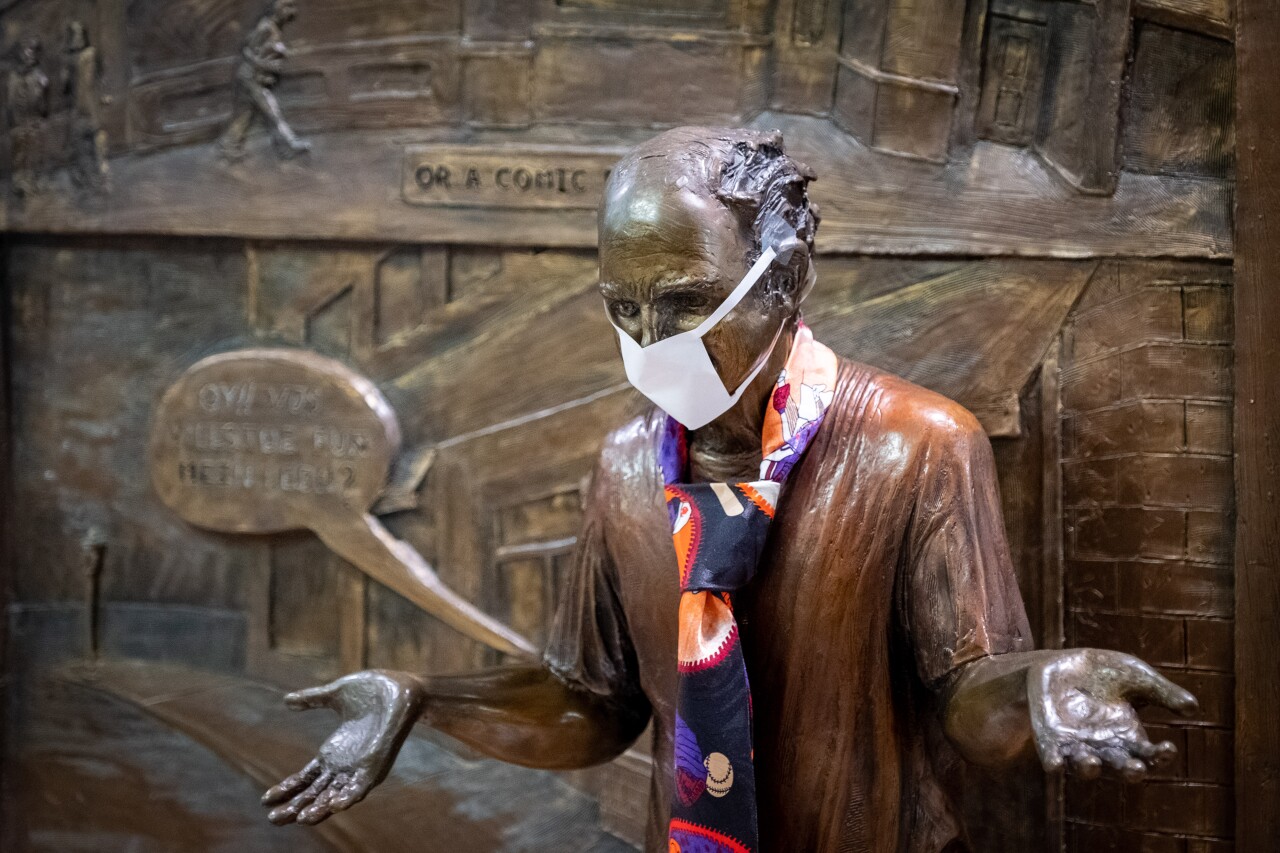
Pekar is buried at Lake View Cemetery. You’ll know the grave when you see it. Fans of his regularly stick dozens of pens in the ground in front of his headstone.
Amherst Train Crash memorial
March 29, 1916

In the early morning hours of March 29, 1916, the small quaint town of Amherst in Lorain County was rocked by a horrific train crash that left dozens of people dead.
It happened just after 3 a.m. near the Amherst Switching Station on the Toledo Division of the New York Central Railroad just a mile west of Amherst.
Two sections of a passenger train were heading east when the conductor of the lead train stopped the engine to check out a signal light that was on. The area was covered in heavy fog and the conductor feared an obstacle may have been on the track or a section damaged. The conductor determined that the signal was an error and started up the train, but he was unable to get the cars moving again from a dead stop.
While the wheels spun on the track, the other section of the train drew closer. That engine crashed into the rear cars of the first train and both derailed. Another train, headed in the opposite direction smashed through both derailed trains just minutes after.

The crash was described as an “awful scene.”
“Corpses were strung along the track, wedged on top of the engines and cars and some thrown to the side of the right of way,” a newspaper article about the crash said. Elyria police officers responded to the scene and helped recover the dead from the wreckage.
In total, 27 people were killed and 47 were injured. Five of the victims, who were unidentified, were buried in Crownhill Cemetery. A monument to those who died can be found at the Sandstone Village in Amherst.
Lorain-Sandusky Tornado marker
June 28, 1924

One of the worst natural disasters to ever happen in the state took place in Lorain around 5 p.m. on June 28, 1924.
A tornado touched down, destroying hundreds of homes and killing 78 people. Fifteen people were killed when the State Theatre collapsed on a crowd watching an afternoon matinee.
In total, 681 houses were destroyed and 7,000 of Lorain’s 40,000 residents were left homeless.
A historical marker is located in a parking lot directly behind Black River landing in the 300 block of Broadway Avenue.
Ashtabula Bridge Disaster
Dec. 19, 1876

On Dec. 19, 1876, one of the deadliest train crashes in U.S. history happened in Ashtabula.
The weather was atrocious and the area was covered with snow. At around 7:30 p.m. The Pacific Express, a two-engine passenger train with 11 cars carrying around 160 people traveling from Buffalo to Cleveland, had just reached a 157-foot-long iron Howe-Truss bridge spanning the Ashtabula River.
While traversing the bridge, the conductor of the train’s head engine, the Socrates, heard a “loud, sickening crack and felt his engine sliding back.” The conductor ordered full steam and barreled ahead. As the train continued on its way, the bridge started to collapse and the second engine, the Columbia, and the cars behind, plummeted more than 70 feet to the icy water below.
Those who weren’t killed by the fall were either crushed or burned alive as flames overcame the wreckage from the oil lamps inside. In total, 92 people were killed in the disaster.
A reporter described the scene as a vision of hell:
“The haggard dawn which drove the darkness out of this valley and shadow of death seldom saw a ghastlier sight than was revealed with the coming of this morning. On each side of the ravine frowned the dark and bare arches from which the treacherous timbers had fallen, while at their base the great heaps of ruins covered the hundred men, women and children who had so suddenly been called to their death. The three charred bodies lay where they had been placed in the hurry and confusion of the night. Piles of iron lay on the thick ice or bedded in the shallow water of the stream. The fires smoldered in great heaps, where many of the hapless victims had been all consumed, men went about in wild excitement seeking some traces of loved ones among the wounded or dead.”
The railroad’s chief engineer, Charles Collins, allegedly knew the bracing on the bridge was faulty. Collins denied responsibility for the bridge collapse. Following his testimony, he was found dead in his home in Cleveland. Initially, his death was ruled a suicide, but forensic evidence found in further investigations did not support the ruling.
The bridge’s designer, Amassa Stone, died from suicide in 1883.

In 1885, a monument was erected and then unveiled at the Chestnut Grove Cemetery in Ashtabula where the remains of the unidentified victims were buried. More than 5,000 Northeast Ohio residents gathered for the dedication. The only intact part of the train that survived the crash, the Socrates, was on display at the event.
Dr. Robert Holbrook “Dr. Bob” Smith
Aug. 8, 1879 - Nov. 16, 1950
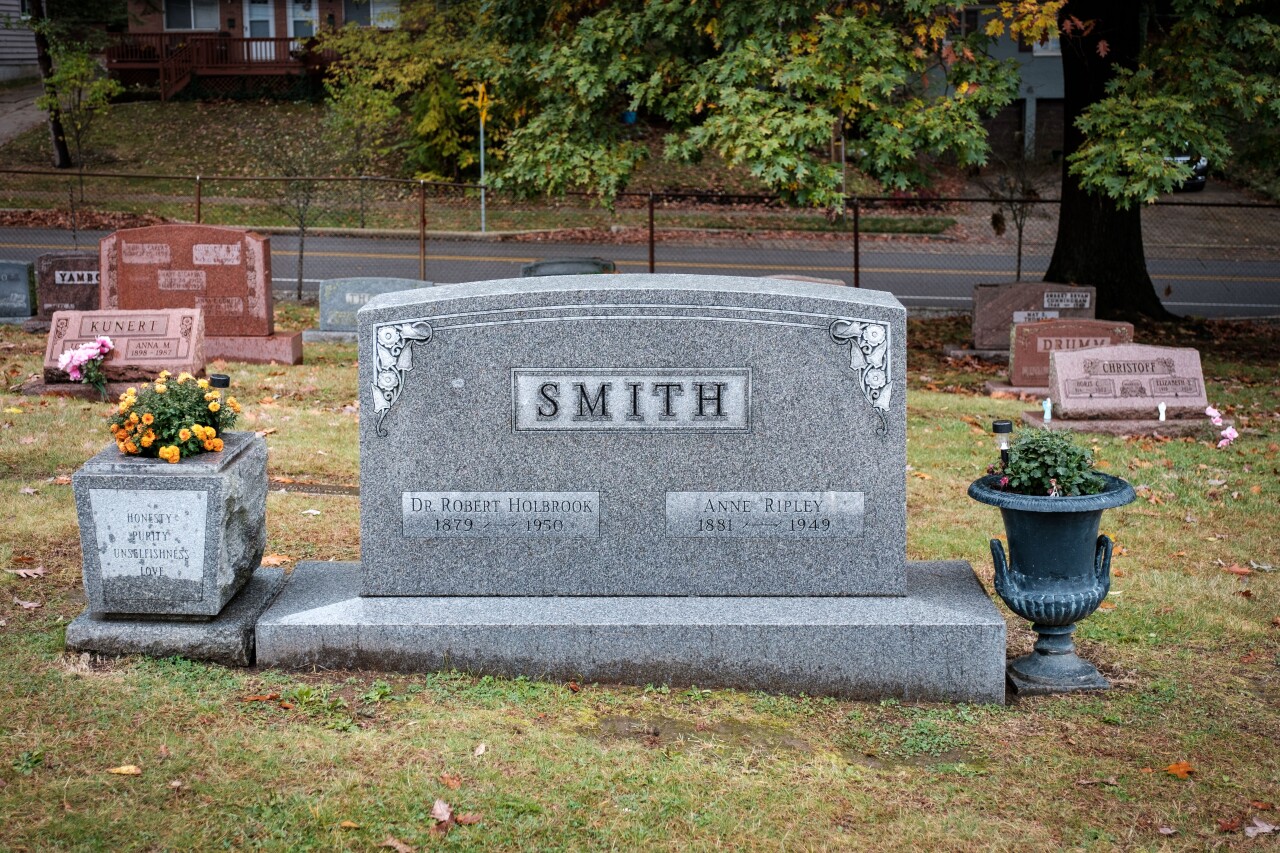
Smith was the co-founder of Alcoholics Anonymous and started the first chapter in Akron at his home.
Smith attended Dartmouth College and Rush Medical School in Chicago. During his studies, Smith developed a drinking habit. Later, as a surgeon, alcoholism consumed him. Everything changed in 1935 when Smith met a New York businessman named Bill Wilson who was also fighting alcoholism.
The two hit it off and became close friends. Wilson and Smith helped each other to recover and Smith took his last drink on June 10, 1935, which became the founding date of Alcoholics Anonymous. Four years later, Wilson published the book, “Alcoholics Anonymous” with stories from Smith and others who fought their addiction.

Smith is credited with helping thousands of alcoholics at St. Thomas Hospital where he worked and visited patients. Smith was referred to as the “Prince of Twelfth Steppers.” He died sober in 1950.
Smith is buried in North Lawn Cemetery, Canton. His home, where AA was born, was placed on the National Register of Historic Places in 1985. It is located at 122 Everett Ave., Akron.
What started as two members in 1935 with Smith and Wilson, AA now has more than 2.1 million members.
If you are struggling with addiction, you can find help here.
Abraham Lincoln’s funeral in Cleveland
Aug. 28, 1865

President Abraham Lincoln was shot and killed on April 15, 1865. Two weeks later, Lincoln’s body stopped in Cleveland on its 1,700-mile railroad trek to Springfield, Illinois for his burial.
While in Cleveland, a wake and funeral was held for the president in Public Square. The Ohio National Guard and the Veteran Reserve Corps stood as honor guards to the procession, which included members of the Army and Navy.

More than 9,000 people gathered at Public Square for a service. By the end of the day, nearly 100,000 people had come to Cleveland to pay their respects.
A historical marker for the president's funeral in Cleveland is located inside the Soldiers and Sailors monument at Public Square.

A statue of Lincoln is also near Mall A at the Drury Hotel Plaza.
Lou “The Toe” Groza
1924 - 2000

Groza was one of the original members of the Cleveland Browns when the team formed in 1946. He retired from the sport in 1967.
Considered one of the best tackles in the sport, he was also known for kicking field goals.
“Kicking was something I did because I had the talent,” Groza famously said. “I always considered myself a tackle.”
He was named to the Pro Bowl nine times and a starting tackle in six of those games. In his 21-year career, he scored 1,608 points and ranked as the all-time top scorer.
In 1950, he scored a 16-yard field goal that gave the Browns a win in the final seconds of the title game against the Los Angeles Rams.
He was inducted into the Pro Football Hall of Fame in 1974. He’s buried in Sunset Memorial Park, North Olmsted.
Smoky the War Dog
1943 - 1957

In March 1944, an American soldier stationed in the Philippines during World War II found a small Yorkshire terrier in a foxhole while crews were working on a nearby Jeep. Another serviceman, Corporal William Wynne, of Cleveland, bought the dog from the man who found her for two Australian pounds and named her Smoky.
The small canine would go on to become a war hero and one of the first service dogs. She's credited with several heroic feats and took part in a dozen combat missions and 150 air raids.
When the Americans were under attack by the Japanese at an airfield at Lingayen Gulf on Luzon, the biggest island in the Philippines, Smoky helped run a wire through a 70-foot-long pipe to connect communications equipment to three squadrons and the base. Without her help, the task would have taken soldiers days to complete and put them under direct fire. That small but heroic act is credited with saving 250 lives and 40 planes.

When Wynne ended up sick in and was sent to a hospital, some of Wynne's fellow soldiers brought his dog to see him and Smoky was an instant hit with the nurses. During his recovery at the hospital, the nurses brought Smoky along their rounds during the day to visit other patients and returned her at night to Wynne where she slept on his bed.
Wynne and Smoky continued to provide therapy for troops. While on furlough in Australia, Wynne and Smoky visited wounded soldiers and helped their recovery. It was so helpful that after the war, Wynne kept visiting wounded veterans with Smoky.
In 2019, the U.S. War Dogs Association presented Wynne with a service award for Smoky. The award, given to military dogs who served in the U.S. Armed Forces, is inscribed, "Faithfully we lead the way."
Smoky died in 1957. She's buried under her memorial on Valley Parkway in Rocky River. There are 11 other monuments around the world built to honor Smoky.

After the war, Wynne worked as a NASA research photographer and a photojournalist for The Plain Dealer. He was inducted into the Ohio Press and Journalism Hall of Fame in Cleveland in 2009. He died in April, 2021.
Download the News 5 Cleveland app now for more stories from us, plus alerts on major news, the latest weather forecast, traffic information and much more. Download now on your Apple device here, and your Android device here.
You can also catch News 5 Cleveland on Roku, Apple TV, Amazon Fire TV, YouTube TV, DIRECTV NOW, Hulu Live and more. We're also on Amazon Alexa devices. Learn more about our streaming options here.





